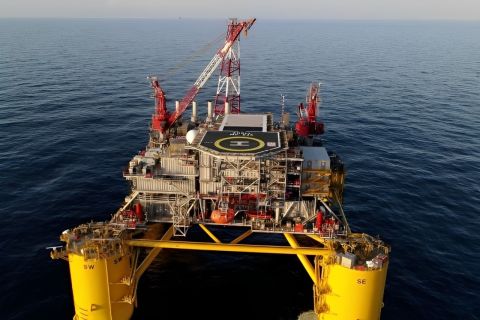Gas producers in Canada have dramatically boosted their drilling efforts during the past few years, but initial productivity of new wells has declined, services and equipment are harder to find and are more expensive, and total production has been flat to sinking. Meanwhile, growing gas demand in Canada may mean a sharp reduction in exports during the next 10 years.
Canada's National Energy Board (NEB) expects the annual average daily deliverability of conventional gas in Canada to decline from 16.7 billion cubic feet (Bcf) in 2004 to about 16.5 Bcf in 2007. Coalbed-methane (CBM) deliverability growth during the same period-from 0.1 Bcf per day to 0.9 Bcf-will fill the gap, the NEB forecasts.
"The industry appears to have developed an understanding of the Horseshoe Canyon coals, and is beginning to scale up the development of this resource," the NEB reports. "Over the long term, the flatter decline profile of [CBM]-and tighter gas-should help slow overall basin declines somewhat."
Bill Gwozd, vice president of gas services for Calgary-based global energy-advisory firm Ziff Energy Group, says conventional gas production in Western Canada has been dropping since 1999. "Any production growth is coming from coalbed methane and tight gas, and even with those growth mechanisms attached, production in Western Canada is still declining."
Cameron Gingrich, lead project analyst for Ziff, says the declining production is not from a lack of drilling. He expects about 15,750 gas wells to be drilled in Western Canada through year-end, and doesn't expect this to fall more than 3%, if that.
Instead, gas-production numbers are slipping due to reduced gas-well productivity. Gwozd says the average well produced 220,000 cubic feet per day in 2005, down 37% from 2000. The declining numbers mean an increasing number of new wells have to be drilled just to keep production flat.
Gwozd says, "The average decline rate for different portions of Western Canada is 30% in the first year for new wells. So, after you drill a well, three or four years later, its production is half over."
Drilling shallow gas wells has dominated the Canadian gas push for a long time. However, in 2005, several of the larger E&P companies put more money into deep-gas exploration. This spending has grown to record levels during the last five years, says Greg Stringham, vice president, markets and fiscal policy, for the Canadian Association of Petroleum Producers.
Smaller producers are still drilling plenty of shallow gas wells, but these have a low initial rate of production, says George Eynon, vice president, business development, for the Canadian Energy Research Institute in Calgary. "In 2005 we drilled about 3,000 coalbed-methane wells. This year we'll drill closer to 4,000 and next year it will probably be more. Coalbed methane will account for nearly 15% to 20% of gas-well completions into 2007. That's huge."
The NEB reports that daily production from the Western Canadian Sedimentary Basin, the source of almost 98% of Canada's gas output, is expected to decrease from 16.3 Bcf to 16 Bcf by next year. To counter, annual gas-well completions are expected to grow from about 16,000 in 2004 to 16,800 by year-end 2007. According to Ziff, there were almost 15,350 gas-well completions in 2005, close to the limit of what is possible in the region in terms of manpower, equipment and rig availability.
Though completions are up from 2005, this is partially due to "left over" wells from last year that are being completed now, Eynon says. Canada kept completions moving forward last year with close to 750 active rigs in the last part of winter. June started off with about 575 rigs-nearly 150 above the five-year average-he adds.
"We've had about seven weeks where the rig count has been around 500-and that's still fairly strong. It's down because the gas-directed activity is lower-given soft prices-but overall, the completions are higher year-to-date. There doesn't seem to be a decline in drilling, but it hasn't grown at the same rate as last winter."
Stringham says gas production is about 300 million cubic feet higher than last year on average. "Year-to-date, we're above last year but much of that was a gain that happened in the first half of the year that flattened off during the summer," he says.
Well licensing (permitting) activity this year-another way to gauge drilling plans-has been slightly ahead of last year. Stringham expects there will be close to 31,000 licenses in 2006 for oil and gas wells combined, but not all of these wells will be drilled near-term.
"When gas prices hit C$4, some producers reconsidered the timing of their wells. Some companies are looking through this soft pricing period and saying they're going to continue to drill in order to have gas available through the winter. Others are saying, 'Why drill it now when I can do it later and still have it onstream for January?'"
Shrinking exports
Canadian gas demand is growing, fueled by oil-sands projects in Alberta, new gas-fired power generation and growing communities. This, coupled with the gradual decline in supply, will mean exports to the U.S. are bound to shrink, Gwozd says.
Gingrich adds, "Even though gas demand is declining slightly from where it was, the girth of the oil-sands projects will drive demand much higher. We see demand going from 0.6 Bcf per day to 2 Bcf by 2015." In 2005, Canada exported some 10 Bcf per day to the U.S.
"Due to demand in Alberta and Ontario's policy decision to shut down existing coal-fired plants to replace them with clean-burning gas alternatives, gas exports will drop to 7.3 Bcf per day by 2014."
A number of factors could turn this around: technological advances in oil-sand plays could reduce the amount of gas required for recovery; coal plants could be revived; producers could suspend oil-sand developments; or, an expected 1.5 Bcf per day of liquefied natural gas may enter the Canadian market by 2014. Any of these could result in increased gas exports to the U.S., Gingrich says.
The demand for gas for power generation eased off this summer when Western Canada and the U.S. Northwest had a good winter in terms of snow pack and precipitation, Eynon says. There was a draw on natural gas for steam and co-electricity generation in the oil sands, but it's been at a predictable rate, he adds.
"Our biggest problem for economic development of the oil sands is not related to natural gas as a fuel or prices. It's related to availability of materials and labor to move the projects forward. There are large construction projects throughout Western Canada, which makes supplying materials a pretty competitive activity."
For now, Eynon and Stringham say there hasn't been a dramatic change in gas exports to the U.S. "Given the flat production, you would have expected a decline in exports, but I don't see that trend in the data," Eynon says. "Many parts of the industrial sector and a good chunk of the power sector have turned away from natural gas as a fuel or a feedstock, flattening the domestic consumption growth. It basically means we've maintained the status quo for the last few years."
Stringham says heavy-oil projects will have a stronger pull on Canada's gas resources as these projects develop. "But at C$4 it makes sense to use natural gas. Companies that have gas as their highest operation cost are looking for cheaper alternatives, and this could free up quantities for other parts of North America."
Long term, Stringham expects exports to stay flat during the next five to 10 years. As CBM production grows, the net declines in conventional areas of gas production could slow and the energy mix will change. "You're going to see quick, strong coalbed-methane growth that wasn't expected a few years ago. Also, the demand for gas in oil sands could definitely be mitigated significantly through technology."
Pricing
With gas prices down, operators see a buying opportunity. Eynon says there are a number of companies-particularly the trust funds-that are looking at asset acquisitions now.
"The only real significant one was Anadarko Petroleum's sale of mostly gas assets to Canadian Natural Resources. But we have a raft of smaller companies and start-ups that have five-year plans. They want to get started, make that initial acquisition, drill some wells, get the growth rate going and then get taken over as quickly as possible. Some management groups have done this a few times, and it's not doing anything fundamental for the gas reserves and production figures."
EnCana Corp. and Canadian Natural have both indicated a decline in their gas-directed drilling based on lower prices, Gwozd says. "If people believe in low-priced gas price-decks, and the idea that prices are going to shoot back up, it creates a huge buying opportunity."
Companies that benefited from high prices during the last nine months have plenty of cash, and they now have the opportunity to go into a low-priced market and pick up competitors-an attractive option since Western Canada is capacity-constrained on drilling, Gingrich says.
Some trusts in Canada are trimming their distributions because lower gas prices have reduced revenues, Stringham adds. The bigger players-EnCana, Talisman Energy Inc. and Canadian Natural-haven't drastically changed their gas-drilling strategy in response to falling prices, he adds.
"They're still drilling a lot of gas wells in resource plays that have low productivity, and they're not slowing down because they're thinking long-term. The marginal gas is what's taken the brunt of any reduction in drilling."
Gas prices are expected to remain low as long as the storage levels stay high. This won't have much of an effect on many long-term investment strategies on the proviso that gas prices will snap back, Gwozd says. Near term, he expects gas will go to C$2, but long-term, it should creep upward to C$7.
The industry is watching winter demand and storage levels. "Gas prices will probably stay soft for the next month or two. The timing and severity of the winter weather will be the biggest determinant of whether it bounces back up to the longer-term views of C$5 to C$6 or whether we see dramatic increases up in the C$10 to C$12 range."
As all of the Canadian producers race to boost year-end gas production, Eynon expects the exit numbers to look pretty good-but not great. "We won't see massive production growth because it's such a heck of a treadmill.
"We've gone from about 2,000 or 3,000 gas-well completions in the 1990s to nearly 14,000 in 2003. In 2004, it was more than 16,000 and last year it was about 17,500-tremendous growth without growth in production. We're just running harder to stand still."
Recommended Reading
TGS Extends Appalachian Basin 3D Seismic Survey
2024-10-23 - TGS said the survey, which is positioned up-dip from the Utica condensate and gas trend, will target 276 sq miles of “key” formations in the Appalachian Basin.
Breakthroughs in the Energy Industry’s Contact Sport, Geophysics
2024-09-05 - At the 2024 IMAGE Conference, Shell’s Bill Langin showcased how industry advances in seismic technology has unlocked key areas in the Gulf of Mexico.
EY: How AI Can Transform Subsurface Operations
2024-10-10 - The inherent complexity of subsurface data and the need to make swift decisions demands a tailored approach.
E&P Highlights: Sep. 2, 2024
2024-09-03 - Here's a roundup of the latest E&P headlines, with Valeura increasing production at their Nong Yao C development and Oceaneering securing several contracts in the U.K. North Sea.
E&P Highlights: Oct. 28, 2024
2024-10-28 - Here’s a roundup of the latest E&P headlines, including a new field coming onstream and an oilfield service provider unveiling new technology.
Comments
Add new comment
This conversation is moderated according to Hart Energy community rules. Please read the rules before joining the discussion. If you’re experiencing any technical problems, please contact our customer care team.





